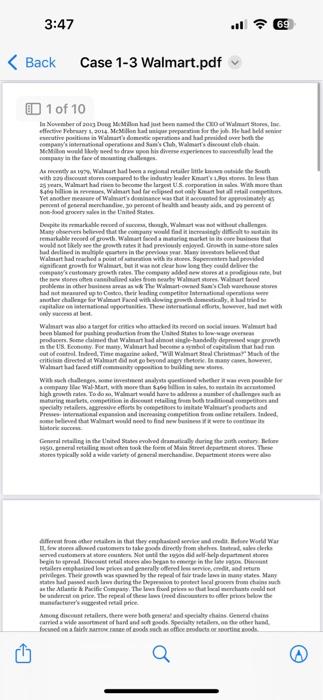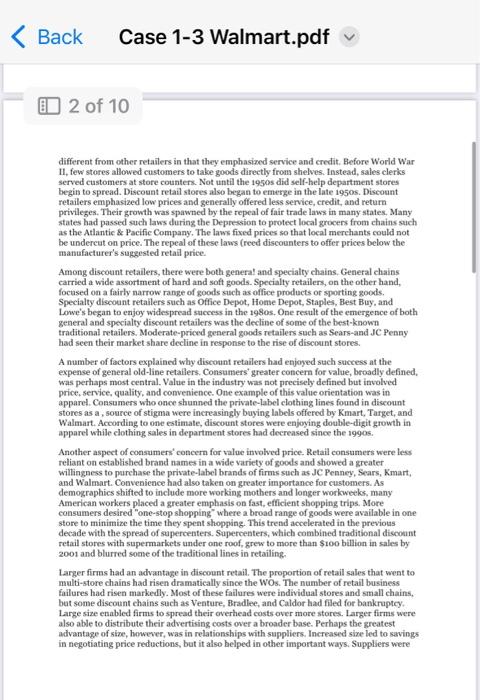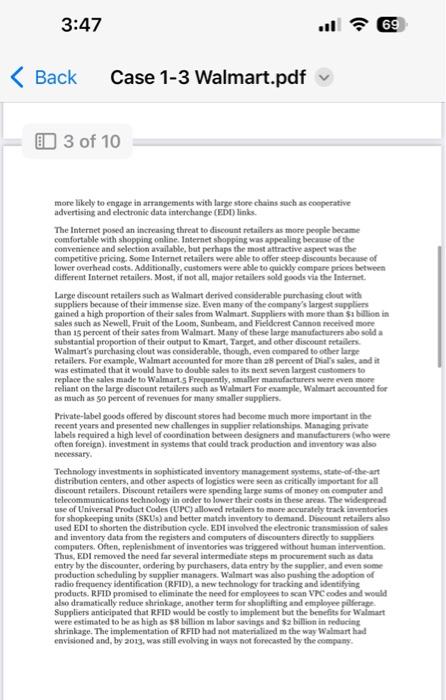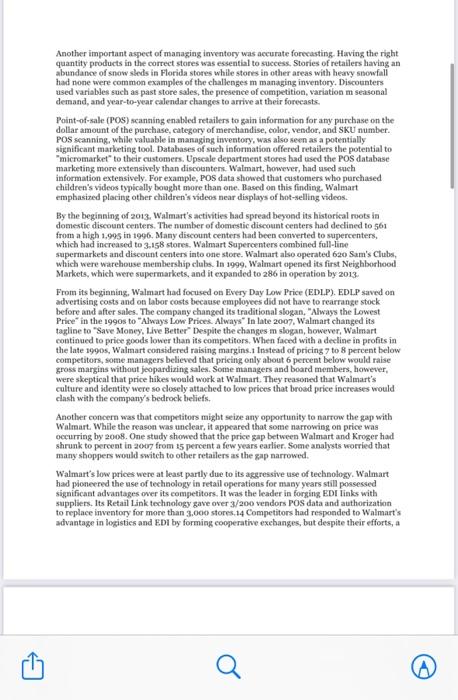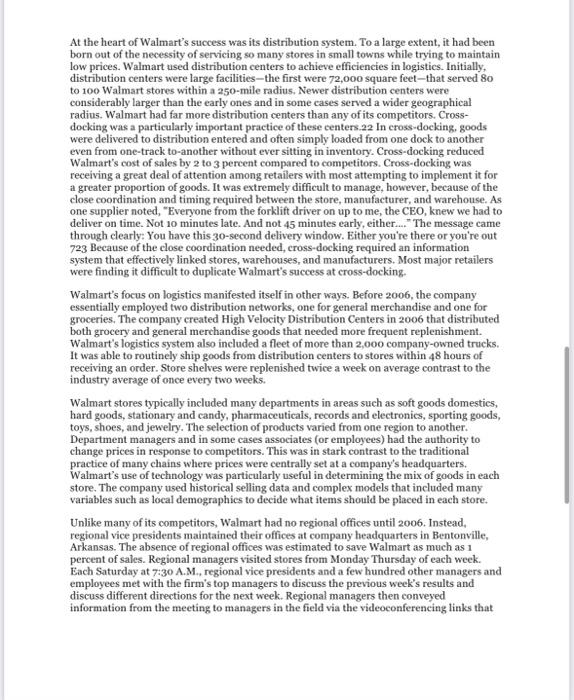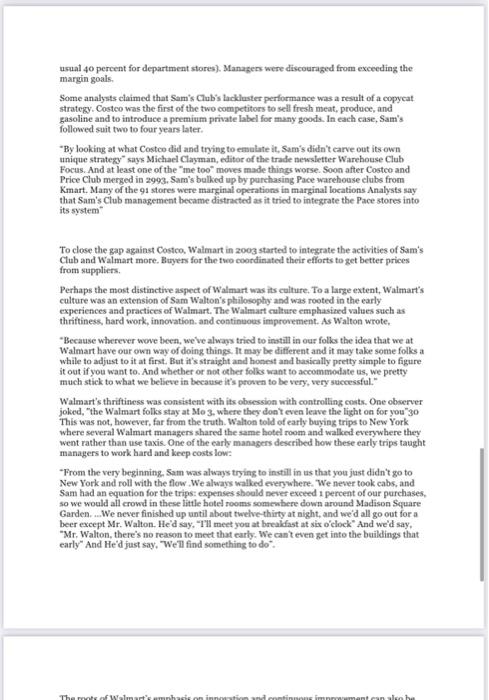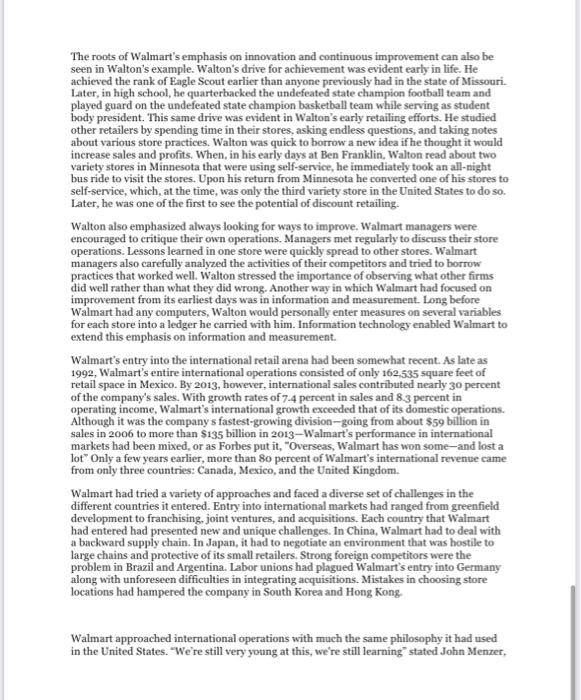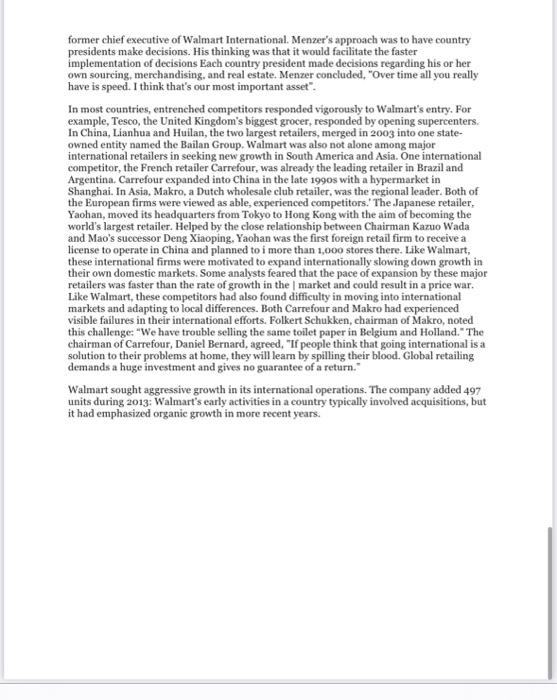- Does Walmart have a competitive advantage?
- Temporary CA?
- Sustainable CA?
- What changes could be made to develop CA and/or create more sustainable CA?
- Are there resources Walmart or its competitors control that are key to CA?
- Financial, Physical, Human, and Organizational?
- Temporary CA?
- Sustainable CA (VRIO)?
- How has Walmart's history shaped its capabilities/resource bundles (Financial, Physical, Human, and Organizational)
- How does Walmart's internal environment drive its strategic and tactical decisions at the organizational and divisional levels (as highlighted in the case)?
- Which of Walmart's capabilities/resources are most important for effective international expansion?
- What adjustments should Walmart make in altering/acquiring capabilities/resources for particular foreign markets (dependent on the differing strategy/tactics it should deploy in these markets)?
rosupasy in the fars of maseating chatlenges. 23 jrans. Walmart had riars Be hecoeme the larkset US. porporatien in sules. Wah mare than noe-foyd erocery cules in the Dnitret States. inty moceses at loit. Walnart was aloo a target for arfics ulhe ampiod its foord on solal lamarb. Walnain bai high growth ratra. To do mo, Walmart wedid hame to addrres a nanber of othaflenzer marh at hiateric soccut. General potaling in the thitod stapresolved dramatically duriag the zarth contery. Findere Mares typically sold at wille varivety of ecternal merchased are, Depurtmonat atena were aloo prindegrs. Their gowth was apawned by the mefral of fair trade laws in mawe states. Mtany an the Atlantic a Pacific Chnepasy. The lawn frond pricea ao thut incal merehasts receld nat thanefautuer's augposed retal grice. differeat from other retailers in that they emphasized service and credit. Before World War II, few stores allowed customers to take goods directly from shelves. Instead, sales clerks served customers at store counters. Not until the 1950 s did self-help department stores begin to spread. Discount retail stores also began to emerge in the late 19505 . Discount retailers emphasized low prices and generally offered less service, credit, and return privileges. Their growth was spawned by the repeal of fair trade laws in many states. Many states had passed such laws during the Depression to protect local grocers from chains such as the Atlantic \& Pacific Company, The laws fixed prices so that local merchants could not be undereut on price. The repeal of these laws (reed discounters to offer prices below the. manufacturer's suggested retail price. Among discotant retailers, there were both genera! and specialty chains, General chains carried a wide assortment of hard and soft goods. Specialty retailers, on the other hand, focused on a fairly narrow range of goods such as office products or sporting goods. Specialty discount retailers such as Office Depot, Home Depot, Staples, Hlest Buy, and Lowe's began to enjoy widespread success in the 1980s. One result of the emergence of both general and specialty discount retailers was the decline of some of the best-known traditional retailers. Moderate-priced general goods retailers such as Sears-and JC Penny had seen their market share decline in response to the rise of discount stores. A number of factors explained why discount retailers had enjoyed such success at the expense of general old-line retailers. Consumers' greater concern for value, broadly defined. was perhaps most central. Value in the industry was not precisely defined but involved price, service, quality, and convenience. One example of this value orientation was in apparel. Consumers who once shunned the private-label clothing lines found in discount stores as a ; sonree of stigma were increasingly buying labels offered by Kmart, Target, and Walmart. According to one estimate, discount stores were enjoying double-digit growth in apparel while clothing sales in department stores had decreased since the 19905. Another aspect of consumers' concern for value invohed price. Retail consumers were less reliant on established brand names in a wide variety of goods and showed a greater willingness to purchase the private-label brands of firms such as JC Penney, Sears, Kmart, and Walmart. Convenience had also taken on greater importance for customers. As demographics shifted to include more working mothers and longer workweeks, many American workers placed a greater emphasis on fast, efficient shopping trips. More consumers desired "one-stop shopping" where a broad range of goods were available in one store to minimize the time they spent shopping. This trend accelerated in the previous decade with the spread of supercenters. Supercenters, which combined traditional discount retail stores with supermarkets under one roof, grew to more than $100 billion in sales by 2001 and blurred some of the traditional lines in retailing- Larger firms had an advantage in discount retail. The proportion of retail sales that went to multi-store chains had risen dramatically since the WOs. The number of retail business failures had risen markedly. Most of these failures were individual stores and small chains, but some discount chains such as Venture, Bradlee, and Caldor had filed for bankruptcy. Large size enabled firms to spread their overhead costs over more stores. Larger firms were also able to distribute their advertising costs over a broader base. Perhaps the greatest advantage of size, however, was in relationships with suppliers. Increased size led to savings in negotiating price reductions, but it also belped in other important ways. Suppliers were more likely to engage in arrangements with large store chains such as eooperative advertising and electronic data interchange (EDI) links. The Internet posed an increasing threat to discount retailers as more people became coenfortable with shopping online. Iaternet shopping was appealing because of the coeveairnce and selection avwilable, but perhaps the most attractive aspert was the competitive pricing. Some Internet retailers were able to offer steep discounts because of lower overhead costs. Additionally, customers werc able to quickly compare prioes betwera different Internet retallers. Most, if not all, major retailers sold goods via the Internet. Large discount retailers such as Walmart derived considerable purchasing doot with suppliers because of their immense siae. Even many of the company's largets ruppliers gained a high proportion of their sales from Walmart. Suppliers with more than $1 bIllion in sales such as Newell, Fruit of the Loom, Sunbeam, and Fielderest Cannon received moce than 15 pereent of their sates from Walmart. Many of these large manufacturers abo scld a sulastantial proportion of their outpet to Kmart, Targit, and other discouat setallen. Walmart's porchasing clout was considerable, though, even compared to other large retailers. For example, Walmart accounted for more than 28 percent of Dral's sales, and it was estimated that it would bave to double sales to its sext seven largest cuatomers to replace the sales made to Walmart. 5 Frecueently, smaller manvofacturers were even moce reliant on the large discount retailers such as Walmart For raample. Walmant aceouated for as mach as 50 percent of revenues for many smaller suppliets. Private-label goods offered by discount stores had become much more important in the receat years and presented new challenges in suppline eclationships. Managing provate labels required a high hevel of coondination between designers and manufacturers (who were. often foreign). investment in systems that could track production and inventory was also necessary. Technolong inventmeats in sophisticated inventory management systems, state-od-the-art distribution ceaters, and otber aspects of logisties were seen as critically important for all discount retailers, Discoust retailers were spending large sums of money en eoemputer and telecommunications technology in order to lower their costs in these areas. The widesipread use of Universal Product Codes (UPC) allowed retailers to more accurately track inventories for sbopkeeping units (SKUs) and better match izventory to demand. Divcount retailers allo used EDI to shorten the distribution cycle. EDI involved the electronic transmiasion of sales and inventory data from the registers and computers of discounters directly to suppliers: coenputers. Often, replenisheneet of inventories was trizgered without human intervention. Thus, EDI removed the need far several intermediate steps m procurement such as data eatry by the discounter, ordering by purchasers, data entry by the supplier, and even soene production scheduling by swpplier managers. Walmart was also pashing the adoption of radio frequency identification (RFID), a new technology for tracking and identifying products. RFID promised to eliminate the need for enployees to scan VPC eodes and would also dramatically reduce shriekage, another term for shoplafting and employee pilferngr Suppliers anticipated that RFID would be costly to implement but the benefits foe Walmart were estimated to be as hizh as $8 billion m labor savings and $2 billion in reducing shrinlage. The implementation of RFW had not materialized m the way Walmart had eavisioned and, by 2013. was still evolving in ways not forveasted by the esenpany. Another important aspect of managing inventory was accurate forecasting. Having the right quantity products in the correct stores was essential to success. Stories of retallers having an abundance of snow sleds in Florida stores while stores in other areas with hearvy smowvfall had none were common examples of the challenges m managing inventory, Discounters used variables such as past store sales, the presence of competition, variation mersonal demand, and year-to-year calendar changes te arrive at their foreeasts. Point-of-sale (POS) scanaing enabled retailers to gain information for any purchase on the dollar amount of the purchase, category of merchandise, color, vendor, and SKU number. POS seanniag, while valuable ia managine inventory, was alse seen as a potentially shignificant marleting tool. Databases of such information offered retailers the potential to "micromarket" to their customers. Upscale department stores had tased the POS database marketing more extensively than discounters. Walmart, bowever, had used such information extensively. For example, POS data showed that customers who purchased children's videos typically bought more than one. Based on this finditu. Walmart emphasized placing other children's videos near displays of hot-selling videos. By the beginning of 2013. Walmart's activities had spread beyond its historieal roots in domestic discount centers. The number of doenestic discount centers had declined to 561 from a high 1,995 in 1996. Many discount centers had been converted to supercenters. which bad increased to 3.158 stores. Walnart Supercenters combined full-line supermarkets and discount centers iato one store. Walnart also operated 620 Sam's Clubs, which were warehouse membership clubs. In 1999. Waimart apened its first Neighborhood Markets, which were supermarkets, and it expanded to 286 in operation by 2013. From its beginning. Walmart had focused on Every Day Low Price (EDI,P). EDL.P saved oa advertising costs and ot labor costs becasise employees did not have to rearrange stock. before and after sales. The company changed its traditional slogan. "Ahays the Lowest Price" in the 1990 to "Always Low Prices. Always" In late 2007, Walmart changed its tagline to "Save Money, Live Better" Despite the changes m shogan, bowever, Walmart continued to price goods lower than iss competitors. When faced with a decline in profits in the late 1990s, Walmart considered raising margins. I Instead of pricing 7 to 8 percent below competitors, some managers believed that prielng only about 6 percent below would raise gross margins without jeopardizing sales. Some managers and board members, however, were skeptical that price hikes would work at Walmart. They reasoned that Walmart's culture and jidentity were so closely attached to low prices that brodd price increases would clash with the company's bedrock heliefs. Another concern was that compethtors might seine any opportunity to narrow the gap with Walmast. While the reason was unclear, it appeared that some narrowing on price was occurring by a0o8. One study showed that the price gap between Walmart and Kroger had shrunk to perceat in 2007 from 15 percent a few years earlier. 5ome analysts worried that many shoppers would switch to other retailers as the gap narrowed. Walmart's low prices were at least partly due to its aggressive use of technology. Walmart had pionecred the use of technology in retail operations for many years still possessed significant advantages over its competitors. It was the leader in forging. EDI links with suppliers. Its Retail Link technology gave over 3/200 vendors POS data and authorization to replace inventory for mone than 3,000 stores, 14 Competitors had responded to Walmart's advantage in logisties and F.DI by forming cooperative exchanges, but despite their efforts, a large gap remained between Walmart and its competitors.15 As a result, Walmart possessed a substantial advantage in information about supply and demand, which reduced both the number of items that were either overstocked or out of stock. November 2003 was also notable for another Walmart technological initiative. It announced plans to implement RFID to all products by January 2005 , a goal that had still not been realized by 2010 . RFID, as its name implies, involves the use of tags that transmit radio signals. It had the potential to track inventory more precisely than traditional methods and to eventually reduce much of the labor involved in activities such as manually scanning bar codes for incoming goods. Some analysts estimated that Walmart's cost savings from RFID could run as high as $8 billion.16 Some information technology observers suggested that Walmart had only experienced lukewarm results from RFID as many suppliers struggled to with the company's demands. Walmart focused its RFID implementation efforts on tagging pallets for Sam's Club stores and promotional displays in Walmarts. Some Sam's Club suppliers were warned they would be assessed a stiff fine for every pallet that was not tagged with RFID, but by 2009 the fines had been reduced to just 12 cents a pallet. Technology was only one area where Walmart exploited advantages through its relationships with suppliers. Walmart's clout was clearly evident in the payment terms it had with its suppliers. Suppliers frequently offered 2 percent discounts to customers who paid their bills within 15 days. Walmart typically paid its bills at close to 30 days from the time of purchase but still usually received a 2 percent discount on the gross amount of an invoice rather than the net amount.17 Several suppliers had attributed performance problems to Walmart's actions. Rubbermaid, for example, experienced higher raw materials costs in the 1990 s that Walmart did not allow it to pass along in the form of higher prices. At the same time, Walmart gave more shelf space to Rubbermaid's lower-cost competitors. As a result, Rubbermaid's profits dropped by 30 percent and it was forced to cut its workforce by more than 1,00o employees.18 Besides pushing for low prices, the large discounters also required suppliers to pick up an increasing amount of inventory and merchandising costs. Walmart required large suppliers such as Procter \& Gamble to place large contingents of employees at its Bentonville, Arkansas, headquarters m order to service its account. Although several companies such as Rubbermaid and the pickle vendor Vlasic had experienced dramatic downfalls largely through being squeezed by Walmart, other companies suggested that their relationship with Walmart had made them much more efficient.19 Some critics suggested, however, that these extreme efficiency pressures had driven many suppliers to move production from the United States to nations such as China that had much lower wages. Walmart set standards for all of its suppliers in areas such as child labor and safety. A 2001 audit, however, revealed that as many as one-third of Walmart's international suppliers were in "serious violation" of the standards. Wal-Mart pursued steps to help suppliers address the violations, but it was unclear how successful these efforts were. A Fast Company article on Walmart interviewed several former suppliers of the company and concluded: "To a person, all those interviewed credit Walmart with a fundamental integrity in its dealings that's unusual in the world of consumer goods, retailing, and groceries. Walmart does not cheat its suppliers, it keeps its word, it pays its bills briskly. They are tough people but very honest; they treat you honestly" says Peter Campanella, a former Coming manager. At the heart of Walmart's success was its distribution system. To a large extent, it had been born out of the necessity of servicing so many stores in small towns while trying to maintain low prices. Walmart used distribution centers to achieve efficiencies in logistics. Initially, distribution centers were large facilities-the first were 72,000 square feet-that served 80 to 100 Walmart stores within a 250-mile radius. Newer distribution centers were considerably larger than the early ones and in some cases served a wider geographical radius. Walmart had far more distribution centers than any of its competitors. Crossdocking was a particularly important practice of these centers.22 In cross-docking, goods were delivered to distribution entered and often simply loaded from one dock to another even from one-track to-another without ever sitting in inventory. Cross-docking reduced Walmart's cost of sales by 2 to 3 percent compared to competitors. Cross-docking was receiving a great deal of attention among retailers with most attempting to implement it for a greater proportion of goods. It was extremely difficult to manage, however, because of the close coordination and timing required between the store, manufacturer, and warehouse. As one supplier noted, "Everyone from the forklift driver on up to me, the CEO, knew we had to deliver on time. Not 10 minutes late. And not 45 minutes early, either.... "The message came through clearly: You have this 30-second delivery window. Either you're there or you're out 723 Because of the close coordination needed, cross-docking required an information system that effectively linked stores, warehouses, and manufacturers. Most major retailers were finding it difficult to duplicate Walmart's success at cross-docking. Walmart's focus on logistics manifested itself in other ways. Before 2006, the company essentially employed two distribution networks, one for general merchandise and one for groceries. The company created High Velocity Distribution Centers in 2006 that distributed both grocery and general merchandise goods that needed more frequent replenishment. Walmart's logistics system also included a fleet of more than 2,000 company-owned trucks. It was able to routinely ship goods from distribution centers to stores within 48 hours of receiving an order. Store shelves were replenished twice a week on average contrast to the industry average of once every two weeks. Walmart stores typically included many departments in areas such as soft goods domestics, hard goods, stationary and candy, pharmaceuticals, records and electronics, sporting goods, toys, shoes, and jewelry. The selection of products varied from one region to another. Department managers and in some cases associates (or employees) had the authority to change prices in response to competitors. This was in stark contrast to the traditional practice of many chains where prices were centrally set at a company's headquarters. Walmart's use of technology was particularly useful in determining the mix of goods in each store. The company used historical selling data and complex models that included many variables such as local demographics to decide what items should be placed in each store. Unlike many of its competitors, Walmart had no regional offices until 2006. Instead, regional vice presidents maintained their offices at company headquarters in Bentonville, Arkansas. The absence of regional offices was estimated to save Walmart as much as 1 percent of sales. Regional managers visited stores from Monday Thursday of each week. Each Saturday at 7:30 A.M., regional vice presidents and a few hundred other managers and employees met with the firm's top managers to discuss the previous week's results and discuss different directions for the next week. Regional managers then conveyed information from the meeting to managers in the field via the videoconferencing links that were present in each store. In 2006 , Walmart shifted this policy by requiring many of its 27 regional managers to live in the areas they supervised. Aside from Walmart's impact on suppliers, it was frequently criticized for its employment practices, which critics characterized as being low in both wages and benefits. Charles Fishman acknowledged that Walmart saved customers $30 billion on groceries alone and possibly as much as $150 billion overall when its effect on competitor pricing was considered, but he estimated that while Walmart created 125,000 jobs in 2005, it destroyed 127,500.25 Others agreed that Walmart's employment and supplier practices resulted in negative externalities on employees, communities, and taxpayers. Harvard professor Pankaj Ghemawat responded to Fishman by calculating that-based on Fishman's numbersWalmart created customer savings ranging from $12 million to $60 million for each job lost.26 He also argued that, because Walmart operated more heavily in lower-income areas of the poorest one-third of the United States, low-income customers were much more likely to benefit from Walmart's lower prices. Another criticism of Walmart was that it consistently drove small local retailers out of business when it introduced new stores in small towns and that employees in such rural areas were increasingly at the mercy of Walmart, essentially redistributing wealth from these areas to Bentonville. Jack and Suzy Welch defended Walmart by pointing out that employees in these areas were better off after a Walmart opened: "In most small towns the storeowner drove the best car, lived in the fanciest house, and belonged to the country club. Meanwhile, employees weren't exactly sharing the wealth. They rarely had life insurance or health benefits and certainly did not receive much in the way of training or big salaries. And few of these storeowners had plans for growth or expansion... a killer for employees seeking life-changing careers." A notable exception to Walmart's dominance in discount retailing was in the warehouse club segment. Despite significant efforts by Walmart's Sam's Club, Costco was the established leader. Sam's Club had almost exactly the same number of stores as Costco-620 to 622 -yet, Costco still reported almost twice the sales-\$105 billion versus $54 billion for Sam's. Costco stores averaged considerably more revenue per store than Sam's Club. To the casual observer, Costco and Sam's Clubs appeared to be very similar. Both charged small membership fees, and both were "warehouse" stores that sold goods from pallets. The goods were often packaged or bundled into larger quantities than typical retailers offered. Beneath these similarities, however, were important differences. Costco focused on more upscale small business owners and consumers while Sam's, following Walmart's pattern, had positioned itself more to the mass middle market. Relative to Costco, Sam's was also concentrated more in smaller cities. Consistent with its more upscale strategy, Costco stocked more luxury and premiumbranded items than Sam's Club had traditionally done. This changed somewhat when Sam's began to stock more high-end merchandise after the 1990 , but some questioned whether or not its typical customers demanded such items. A Costco executive pointed to the differences between Costco and Sam's customers by describing a scene where a Sam's customer responded to a $39 price on a Ralph Lauren Polo shirt by saying "Can you imagine? Who in their right mind would buy a t-shirt for $39 ?" Despite the focus on pricier goods, Costco still focused intensely on managing costs and keeping prices down. Costco set a goal of ten percent margins and kept capped markups at 14 prevent (compared to the usual 40 percent for department stores). Managers were discouraged from exceeding the margin goals. Some analysts claimed that Sam's Club's lackluster performance was a result of a copycat strategy. Costco was the first of the two competitors to sell fresh meat, produce, and gasoline and to introduce a premium private label for many goods. In each case, Sam's followed suit two to four years later. "By looking at what Costco did and trying to emelate it, Sam's didn't carve out its own unique strategy" says Michael Clayman, editor of the trade newsletter Warehouse Club Focus. And at least one of the "me too" moves made things worse. Soon after Costco and Price Club merged in 2993 . Sam's bulked up by purchasing Pace warehouse clubs from Kmart. Many of the 91 stores were marginal operations in marginal locations Analysts say that Sam's Club management became distracted as it tried to integrate the Pace stores into its system' To close the gap against Costco, Walmart in 2003 started to integrate the activities of Sam's Club and Walmart more. Buyens for the fwo coordinated their efforts to get better prices from suppliers. Perhaps the most distinctive aspect of Walmart was its culture. To a lange extent, Waimart's culture was an extension of Sam Walton's philosophy and was rooted in the early experiences and practices of Walmart. The Walmart culture emphasined values such as thriftiness, hard work, innovation. and continuous improvement. As Walton wrote, "Because wherever wove been, we've always tried to instill in our follos the idea that we at Walmart have our own way of doing things. It may be different and it may take some folks a while to adjust to it at first. Bat it's straight and honest and basically pretty simple to figure it out if you want to. And whether or not other folks want to accommodate us, we pretty much stick to what we believe in because it's prowen to be very, very successful." Walmart's thriftiness was consistent with its obsession with controlling coats. One observer joked, "the Walmart folks stay at Mo 3. where they don' even leave the light on for you"30 This was not, however, far from the truth. Walton told of early buying trips to New York where several Walmart managers shared the same hotel room and walked everywhere they went rather than use taxis. One of the early managers described how these early trips taught managers to work hard and keep costs low: 'From the very beginning. Sam was always trying to instill in us that you just didn't go to New York and roll with the flow. We always walked everywhere. We never took cabs, and Sam had an equation for the trips: expenses should never exceed 1 percent of our purchases, so we would all crowd in these little hotel rooms somewhere down around Madison Square Garden. ...We never finished up until about tweive thirty at night, and we'd all go out for a beer except Mr. Walton. He'd say. "I'll meet you at brealfast at six o'clock" And we'd say, "Mr. Walton, there's no reason to mect that early. We can't even get into the buildings that early" And He'd just say, "Weill find something to do". The roots of Walmart's emphasis on innovation and continuous improvement can also be seen in Walton's example. Walton's drive for achievement was evident early in life. He achieved the rank of Eagle Scout earlier than anyone previously had in the state of Missouri. Later, in high school, he quarterbacked the undefeated state champion football team and played guard on the undefeated state champion basketball team while serving as student body president. This same drive was evident in Walton's early retailing efforts. He studied other retailers by spending time in their stores, asking endless questions, and taking notes about various store practices. Walton was quick to borrow a new idea if he thought it would increase sales and profits. When, in his early days at Ben Franklin, Walton read about two variety stores in Minnesota that were using self-service, he immediately took an all-night bus ride to visit the stores. Upon his return from Minnesota he converted one of his stores to self-service, which, at the time, was only the third variety store in the United States to do so. Later, he was one of the first to see the potential of discount retailing. Walton also emphasized always looking for ways to improve. Walmart managers were encouraged to critique their own operations. Managers met regularly to discuss their store operations. Lessons learned in one store were quickly spread to other stores. Walmart managers also carefully analyzed the activities of their competitors and tried to borrow practices that worked well. Walton stressed the importance of observing what other firms did well rather than what they did wrong. Another way in which Walmart had focused on improvement from its earliest days was in information and measurement. Long before Walmart had any computers, Walton would personally enter measures on several variables for each store into a ledger he carried with him. Information technology enabled Walmart to extend this emphasis on information and measurement. Walmart's entry into the international retail arena had been somewhat recent. As late as 1992, Walmart's entire international operations consisted of only 162,535 square feet of retail space in Mexico. By 2013, however, international sales contributed nearly 30 percent of the company's sales. With growth rates of 7.4 percent in sales and 8.3 percent in operating income, Walmart's international growth exceeded that of its domestic operations. Although it was the company s fastest-growing division - going from about $59 billion in sales in 2006 to more than $135 billion in 2013 -Walmart's performance in international markets had been mixed, or as Forbes put it, "Overseas, Walmart has won some-and lost a lot" Only a few years earlier, more than 80 percent of Walmart's international revenue came from only three countries: Canada, Mexico, and the United Kingdom. Walmart had tried a variety of approaches and faced a diverse set of challenges in the different countries it entered. Entry into international markets had ranged from greenfield development to franchising, joint ventures, and acquisitions. Each country that Walmart had entered had presented new and unique challenges. In China, Walmart had to deal with a backward supply chain. In Japan, it had to negotiate an environment that was hostile to large chains and protective of its small retailers. Strong foreign competitors were the problem in Brazil and Argentina. Labor unions had plagued Walmart's entry into Germany along with unforeseen difficulties in integrating acquisitions. Mistakes in choosing store locations had hampered the company in South Korea and Hong Kong. Walmart approached international operations with much the same philosophy it had used in the United States. "We're still very young at this, we're still learning" stated John Menzer, former chief executive of Walmart International. Menzer's approach was to have country presidents make decisions. His thinking was that it would facilitate the faster implementation of decisions Each country president made decisions regarding his or her own sourcing, merchandising, and real estate. Menzer concluded, "Over time all you really have is speed. I think that's our most important asset". In most countries, entrenched competitors responded vigorously to Walmart's entry. For example, Tesco, the United Kingdom's biggest grocer, responded by opening supercenters. In China, Lianhua and Huilan, the two largest retailers, merged in 2003 into one stateowned entity named the Bailan Group. Walmart was also not alone among major international retailers in seeking new growth in South America and Asia. One international competitor, the French retailer Carrefour, was already the leading retailer in Brazil and Argentina. Carrefour expanded into China in the late 1990 with a hypermarket in Shanghai. In Asia, Makro, a Dutch wholesale club retailer, was the regional leader. Both of the European firms were viewed as able, experienced competitors. 'The Japanese retailer, Yaohan, moved its headquarters from Tokyo to Hong Kong with the aim of becoming the world's largest retailer. Helped by the close relationship between Chairman Kazuo Wada and Mao's successor Deng Xiaoping. Yaohan was the first foreign retail firm to receive a license to operate in China and planned to i more than 1,000 stores there. Like Walmart, these international firms were motivated to expand internationally slowing down growth in their own domestic markets. Some analysts feared that the pace of expansion by these major retailers was faster than the rate of growth in the | market and could result in a price war. Like Walmart, these competitors had also found difficulty in moving into international markets and adapting to local differences. Both Carrefour and Makro had experienced visible failures in their international efforts. Folkert Schukken, chairman of Makro, noted this challenge: "We have trouble selling the same toilet paper in Belgium and Holland." The chairman of Carrefour, Daniel Bernard, agreed, "If people think that going international is a solution to their problems at home, they will learn by spilling their blood. Global retailing demands a huge investment and gives no guarantee of a return." Walmart sought aggressive growth in its international operations. The company added 497 units during 2013: Walmart's early activities in a country typically involved acquisitions, but it had emphasized organic growth in more recent years
